Rapidly changing circumstances
In the coming years, minerals processing will face an unavoidable shakedown. A growing global population and an accelerating economy will increase the demand for minerals, while at the same time mineral processing will become more difficult every year. Increasing production output during a time when natural resource depletion is a major factor will be one of the greatest challenges. Also, environmental concerns have to be taken into ever-closer consideration. This article looks at some of the problems facing the mining industry in the next five years and explores some of the possible solutions. The information and insights referred to in this piece are based on peerreviewed scientific research, expert reports, and studies conducted in the industry.
Inevitable growth pressure
Demand for most metals is rising fast. From about 400 tonnes per year of gold production in 1900,current production is over 2,500 tonnes per year. Similarly, a century ago, copper production was only a couple of hundred thousand tonnes per year and today it is over 18 million tonnes. Just like the demand for metals, the demand for industrial minerals, coal and other mined commodities is rising as well (U.S. Geological Survey, Mineral Commodities Summaries, January 2016). What is interesting is that there is a strong correlation between the growing demand for metals and the global population growth. The United Nations estimates that by 2100, the world will have about 11 billion people (United Nations, 2017 Revision of World Population Prospects, June 2017), so the stage is certainly set for another century of continued growth in the mining industry.
Taking action to improve
Under these prevailing circumstances, mining companies and equipment suppliers have the responsibility to improve their production efficiency and reduce both energy and water consumption per unit of production. It is a matter of both business survival and environmental performance. This is far from a simple task, but new technologies that make better use of energy, water, data and automation will help the industry rise to the occasion. Some of the most effective and applicable of those new solutions include increased blasting, early rejection of gangue, advanced process control, optimal linear design, primary grinding with high-pressure grinding rolls (HPGRs), and dewatered tailings.
Increasing throughput with lower energy consumption
Why crush rocks when you can blow them up, right? Increasing blasting of ore upstream of crushing is just one of the ways to increase throughput while decreasing energy consumption. It allows you to reduce the feed size of ore prior to primary crushing, allowing for decreased energy consumption during the crushing process itself. Increased blasting can reduce the feed size of ore to the primary crushers, cut down their power draw, and create more fines for downstream processes. As a result, it increases throughput and lowers energy consumption. Finally, depending on the price of drilling and blasting relative to the price of energy, the potential is there to reduce overall operating costs by as much as 20% (McKee, D., Understanding Mine to Mill, The Cooperative Research Centre for Optimizing Resource Extraction, 2013).
Rejection of gangue earlier in the process is yet another way to potentially improve efficiency and decrease energy consumption. This in essence is a mind-set change from the traditional “grind everything first, then concentrate” way of thinking. For an ore that has distinct banded zones, it makes less sense to grind the entire chunk down to 180 microns and then concentrate. Instead, it is common practice to crush or coarse grind just enough to liberate the gangue and separate it from the valuable iron-bearing minerals. After separation, you are left with a lot less material to grind down to liberate the iron from the bound silica. The best performers are the ones who keep their eyes open, take advantage of insights, and are not afraid to change in the foreground.
New technology is our friend in achieving sustainability
The comminution process, which includes both crushing and grinding, is one of the world’s most energy-intensive industrial processes. With present technology and mine production rates, comminution uses at least 3% of total global electricity production (Jeswiet, J. and Szekeres, A., ScienceDirect, Energy Consumption in Mining Comminution, 2016), and according to the Coalition for Energy Efficient Comminution, it accounts, on average, for more than 50% of a mine’s energy consumption and 10% of total production costs. So, anything we can do to improve energy efficiency in comminution will have a great impact on the bottom line and environmental performance alike.
High-pressure grinding rolls have evolved to allow effective and efficient processing of hard ores. Grinding mills with a dry circuit need less energy and water. These crusher technologies allow media consumption to be reduced, fines production to be increased, and comminution energy use to be cut down by up to 25% compared to SAG or AG milling, making a considerable difference. Conservation of water is important, not only in HPGR applications, but across the entire mining process. Other ways to conserve water and reduce the load on nature are dewatered stacking of tailings and advanced ore sorting. Less water in tailings means a smaller footprint of the tailings storage facility and less risk of groundwater contamination through seepage. Advanced ore sorting, on the other hand, increases the purity of the material and reduces water needed in beneficiation.
Digitalization and advanced automation
More often than not our approach to correcting problems in minerals processing has been reactive, and solutions have come with a time delay. Digitalization, however, will transform the mining industry at an accelerating pace by providing a much higher level of dynamic information for early corrections. Digital tools, such as advanced process control and optimized control systems, maximize recovery and reduce energy demands by improving quality management during operation. Advanced process control, along with other software tools such as multidimensional simulations, allow operating closer to the efficiency frontier by constantly monitoring, reacting, adjusting, and optimizing the process – resulting in better throughput with less energy.
Light at the end of the tunnel
Despite population growth, increasing energy prices and water consumption, the mining industry has tools to meet the challenges. On-going technological development is generating solutions to problems faster than ever, but the mining companies also need to adopt a more inclusive approach whereby problems, which vary in nature and dimension, are solved with an integrated approach and by optimizing end-to-end operations. In that competition, those who stay still will be left behind – and the best performers are the ones who keep their eyes open, take advantage of insights, and are not afraid to change in the foreground.

